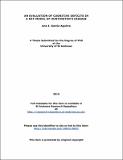Files in this item
An evaluation of cognitive deficits in a rat-model of Huntington's disease
Item metadata
| dc.contributor.advisor | Brown, Verity Joy | |
| dc.contributor.advisor | Bowman, Eric MacDonald | |
| dc.contributor.author | García Aguirre, Ana I. | |
| dc.coverage.spatial | vii, 291 p. | en_US |
| dc.date.accessioned | 2016-05-19T11:23:52Z | |
| dc.date.available | 2016-05-19T11:23:52Z | |
| dc.date.issued | 2016-06-21 | |
| dc.identifier | uk.bl.ethos.687022 | |
| dc.identifier.uri | https://hdl.handle.net/10023/8827 | |
| dc.description.abstract | The purpose of this thesis was to develop methodology by which treatments for the cognitive impairments in Huntington’s disease (HD) could be tested. As such, the thesis focused mainly on evaluating rats with quinolinic acid (QA) lesions of the striatum, as this manipulation mimics some aspects of the neural damage in Huntington’s disease, to try to identify cognitive deficits of HD resulting from cell loss in the striatum. In the first part (Chapters 3-5), the role of the striatum in implicit memory was investigated. Chapter 3 compared the performance of rats and humans on a reaction time task that evaluated implicit memory by presenting visual stimuli with differing probabilities which change over time. Although rats made higher percentage of incorrect responses and late errors, both groups showed a similar pattern of reaction times. Chapter 4 investigated whether implicit memory (the computation of probabilities to predict the location of a stimulus) was affected by selective blockade of dopaminergic transmission at the D1 or D2 receptors by SCH-23390 and raclopride, respectively. Reaction times were slower with SCH-23390 and raclopride, but only SCH-23390 reduced errors to the least probable target location. Chapter 5 used the same task to evaluate implicit memory in rats with QA lesions of the dorsomedial striatum (DMS). Implicit memory was not affected by lesions of the DMS, which suggested that once a task that requires implicit memory has been learned, the DMS was not involved in sustaining the performance of the task. The second part of this thesis (Chapter 6), explored the contribution of the DMS in habit formation. DMS lesioned rats did not show habitual responding, and were not impaired in learning a new goal-directed behaviour. The third part (Chapters 7 and 8), investigated the role of the dorsal striatum in reversal learning, attentional set-formation, and set-shifting. Dorsal striatum lesioned rats were not impaired in reversal learning, but had a diminished shift-cost, which suggested that dorsal striatum lesions disrupted the formation of attentional sets. These results showed that although QA lesions of the dorsal striatum mimic some aspects of the neural damage in HD, they did not result in the same cognitive deficits observed in patients with HD, at least using the tasks presented in this thesis. However, other animal models of HD could be evaluated using the different tasks presented in this thesis to continue the search of a reliable animal model of HD in which treatments for the disease could be evaluated. | en_US |
| dc.language.iso | en | en_US |
| dc.publisher | University of St Andrews | |
| dc.subject | Huntington's disease | en_US |
| dc.subject | Excitotoxic lesion | en_US |
| dc.subject | Quinolinic acid | en_US |
| dc.subject | Striatum | en_US |
| dc.subject | Cognitive deficits | en_US |
| dc.subject | Implicit memory | en_US |
| dc.subject | Reaction time task | en_US |
| dc.subject | Habit formation | en_US |
| dc.subject | Goal-directed behaviour | en_US |
| dc.subject | Behavioural flexibility | en_US |
| dc.subject | Reversal learning | en_US |
| dc.subject | Attentional set-formation | en_US |
| dc.subject | Set-shifting | en_US |
| dc.subject.lcc | RC394.H85G2 | |
| dc.subject.lcsh | Huntington's disease--Animal models | en_US |
| dc.subject.lcsh | Huntington's disease--Treatment--Evaluation | en_US |
| dc.subject.lcsh | Cognition in animals | en_US |
| dc.subject.lcsh | Rats--Physiology | en_US |
| dc.subject.lcsh | Implicit memory | en_US |
| dc.title | An evaluation of cognitive deficits in a rat-model of Huntington's disease | en_US |
| dc.type | Thesis | en_US |
| dc.contributor.sponsor | Consejo Nacional de Ciencia y Tecnología (CONACyT) (Mexico) | en_US |
| dc.contributor.sponsor | TTP Global Development | en_US |
| dc.type.qualificationlevel | Doctoral | en_US |
| dc.type.qualificationname | PhD Doctor of Philosophy | en_US |
| dc.publisher.institution | The University of St Andrews | en_US |
This item appears in the following Collection(s)
Items in the St Andrews Research Repository are protected by copyright, with all rights reserved, unless otherwise indicated.

